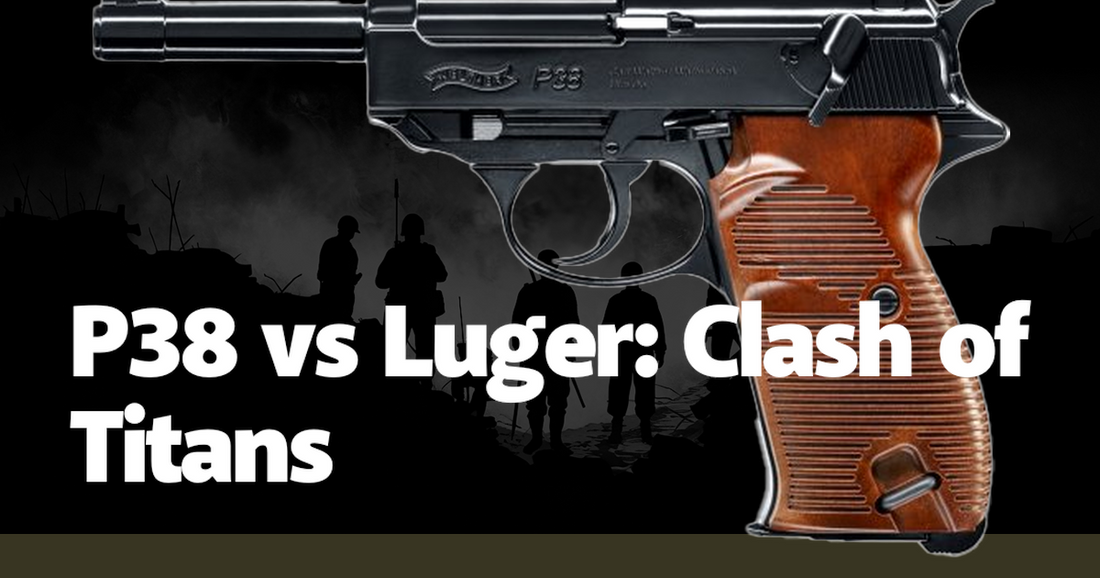In the annals of military history, few rivalries are as storied or as fascinating as that between the Walther P38 and the Luger P08. These two German pistols, both icons of their time, have been pitted against each other in countless comparisons, each vying for the title of the superior sidearm. The P38, introduced during the tumultuous years of World War II, was a marvel of modern engineering, designed to replace the venerable Luger P08, which had served the German military since the early 20th century. This clash between old and new, tradition and innovation, is a microcosm of the broader technological and strategic shifts that defined the era.
The Luger P08, with its distinctive toggle-lock mechanism and sleek, ergonomic design, was a product of its time. It was first adopted by the German military in 1908 and quickly became a symbol of German engineering prowess. Its precision and reliability under fire made it a favorite among soldiers, and its unique design set it apart from other pistols of the era. However, the Luger was not without its flaws. Its complex mechanism was prone to jamming if not meticulously maintained, and its production was both time-consuming and expensive. Despite these issues, the Luger earned a reputation as a formidable weapon, its distinctive silhouette becoming synonymous with German military might.
Enter the Walther P38, a pistol born out of necessity and designed for the rigors of modern warfare. The P38 was developed in the late 1930s as a more efficient and reliable alternative to the Luger. Its design incorporated several innovative features, including a double-action trigger and a simpler locking mechanism, which made it easier to produce and maintain. The P38's robust construction and reliability under harsh conditions quickly won it favor among German troops. It was also one of the first pistols to feature a decocking lever, enhancing safety and usability. In many ways, the P38 represented the future of military sidearms, combining practicality with cutting-edge technology.
Despite the P38's advantages, the Luger P08 remained in service throughout World War II, a testament to its enduring appeal and effectiveness. Many soldiers preferred the Luger for its superior accuracy and balance, qualities that were especially valued by marksmen and officers. Anecdotes from the front lines often highlight the Luger’s precision, with some soldiers going to great lengths to acquire one as a personal sidearm. This preference was not merely nostalgic; the Luger’s design, while antiquated, still held certain advantages in specific combat scenarios. Its longer barrel and superior craftsmanship made it a highly accurate weapon, capable of delivering precise shots even at extended ranges.
The rivalry between the P38 and the Luger P08 extended beyond the battlefield, influencing the post-war firearms market and collectors' circles. After the war, both pistols became highly sought after by collectors and enthusiasts, each representing a different era of German military history. The P38's modern design and historical significance made it a popular choice, while the Luger’s iconic status and intricate engineering continued to captivate collectors. This enduring interest has kept the debate alive, with aficionados passionately defending their preferred pistol. The legacy of these weapons is a testament to their impact, not just as tools of war, but as symbols of a pivotal period in history.
One particularly illustrative example of the P38's impact can be found in the story of Major General Matthew Ridgway, a prominent U.S. Army officer during World War II. Ridgway, who would later become a key figure in the Korean War, famously carried a captured P38 as his personal sidearm. He praised the pistol for its reliability and ease of use, qualities that were essential in the chaotic and often brutal conditions of the front lines. Ridgway’s choice of the P38 over the standard-issue M1911 speaks volumes about the pistol’s capabilities and the respect it garnered even among enemy forces.
Conversely, the Luger P08 found its way into the hands of many Allied soldiers as a prized war trophy. Stories abound of soldiers risking their lives to capture a Luger from a fallen enemy, such was the pistol's allure. The Luger’s distinctive design and reputation made it a highly coveted souvenir, a tangible piece of the enemy’s might. This fascination was not just limited to soldiers; after the war, Lugers became popular among civilian shooters and collectors, further cementing their legendary status. The Luger’s mystique, combined with its historical significance, ensured that it would remain a topic of fascination for generations to come.
In the end, the clash between the P38 and the Luger P08 is more than a comparison of two pistols; it is a reflection of the broader changes in military technology and strategy during the first half of the 20th century. The P38 represented a shift towards more practical and efficient weaponry, designed for mass production and reliability. The Luger, on the other hand, was a product of an earlier era, where craftsmanship and precision were paramount. Both pistols have left an indelible mark on history, and their rivalry continues to captivate enthusiasts and historians alike. As symbols of their time, the P38 and the Luger P08 remind us of the relentless march of progress and the enduring allure of excellence in design.

